Preprint
Article
Baseline Knowledge of Peripheral Arterial Disease and Factors Influencing Learning Material Preferences in the San Francisco Chinese-Speaking Community: A Survey Analysis
This version is not peer-reviewed.
Submitted:
27 October 2024
Posted:
28 October 2024
You are already at the latest version
A peer-reviewed article of this preprint also exists.
Abstract
Background: Peripheral Artery Disease (PAD) affects tens of millions of Americans, and is characterized by the accumulation of plaque within arteries in the arms and legs. Advanced age is a risk factor for PAD, and early recognition through health literacy is imperative to mitigate limb loss. The influence of health literacy on PAD outcomes remains poorly understood, particularly in minoritized communities. The objective of this study is to examine understanding of PAD within San Francisco’s Chinese-speaking population, while discerning preferences regarding PAD educational methods.
Material and Methods: An anonymous 14-question survey in Mandarin and English was designed to gauge basic knowledge of PAD and preferred methods for obtaining health information. It was distributed at San Francisco Chinatown health fairs on May 6 and October 14, 2023. Inferential analysis was concentrated on the associations between age, self-reported gender and English proficiency versus PAD baseline knowledge as well as preferred methods to obtain health information.
Results: Combining the two surveyed cohorts, 32% of the survey population (29/91) reported prior knowledge about PAD. individuals aged 65-74 were the most prevalent age group. 29/91 had prior knowledge of PAD. While many survey respondents thought that diabetes was a leading cause for PAD (47/76) and arthritis was thought to be the leading symptom related to PAD (32/65). Half of respondents (44/88) expressed a preference for consulting a family doctor for foot wounds, followed by a podiatrist (27/88) and a general surgeon (19/88). The two cohorts that were surveyed had similar and suboptimal understanding of PAD and its complications which confirmed a health literacy gap among the Chinese-speaking population. The top three methods to receive health information were radio, television and newspaper. Interestingly, 65 years old and above (OR 0.124, 95% CI [0.021- 0.0728]) as well as participants who were proficient in English (OR 0.078; 95% CI [0.012-0.52]) were less preferred using radio to receive health information. Male gender was statistically significant to use newspapers to receive health information as opposed to female (p=0.003, OR 5.26; 95% CI [1.76-15.69]).
Discussion:
Conclusion: The two cohorts that were surveyed had similar and suboptimal understanding of PAD and its complications, which confirmed a health literacy gap among the Chinese-speaking population in San Francisco. To address this gap, factors such as age, education level, and gender need to be better understood in their relation to the impact of learning methods in this population.
Keywords:
Peripheral Artery Disease
Introduction
Among many medical conditions, peripheral arterial disease (PAD) is a devastating condition, affecting around 10% of the United States population [1]. Its debilitating complications include gangrene, non-healing wounds, lower extremity amputations, as well as ischemic pain.[2] Risk factors related to PAD are similar to other cardiovascular diseases. Although advanced age is a risk factor to develop PAD, early recognition of the signs of PAD are imperative to mitigate the chance of limb loss which is linked to increased risk of mortality due to the decline of function after limb loss.[3] While treatment options are available, the advocacy for PAD prevention and recognition gains more attention until recent years. The impact of PAD and its complications on the minorities is also disproportionately more prevalent than among non-hispanic white.[4] Given that the evidence has suggested that diabetic foot ulcers are related to lower socioeconomic status and that diabetes and associated complications are associated with the increased risk of PAD development, [5] lack of understanding of the disease may be a contributing factor to limb loss due to PAD.
To our knowledge, the understanding of PAD in subsets of minorities is not well known. Health literacy, closely intertwined with factors like education, income, and access to healthcare, is pivotal in addressing health disparities.[6] Improving health literacy through interventions can empower individuals and communities to tackle social and economic determinants of health, enhancing the utilization of preventive services and adherence to medical advice.[6] By integrating health literacy with behavior change theories, interventions have the potential to significantly reduce disease burden and achieve greater equity in disease outcomes.[7] However, despite the promising effects of enhancing health literacy, public education about PAD lags appears to be behind other health conditions like diabetes, stroke, or heart disease until recent years.[2,8] Low health literacy correlates with increased hospitalizations, emergency care usage, and decreased preventive service utilization.[9] It also relates to challenges in interpreting health messages, poorer health status, higher mortality rates, and elevated healthcare costs. [10]
The factors that influence an individual’s health literacy can be multifactorial and complex. Anecdotally, we observe a knowledge gap in PAD and its complications among the Chinese-speaking population in San Francisco Chinatown. Patients in this specific population often present chronic non-healing wounds and rest pain due to underlying PAD. When they seek care, they often request topical ointment to heal the wound and have very little understanding of the direct relationship between peripheral circulation and wound healing. This observation highlights the lack of awareness and baseline knowledge in PAD and its complications. To investigate the baseline understanding of PAD and its complication within the Chinese-speaking population of San Francisco, the primary objective of this study is to survey the foundational understanding of PAD and learning preferences. Through the findings of this project, we aim to uncover insights that can inform targeted educational initiatives and ultimately enhance the management and prevention of PAD within this specific demographic.
Materials and Methods
An anonymous 14-question survey written in Mandarin and English was designed to gauge the basic knowledge of PAD and preferred method for obtaining health information [Appendix A]. The paper survey was distributed at the health fairs in San Francisco Chinatown on May 6, 2023, and October 14, 2023. Respondents who were not able to read the survey completed the survey as the student volunteers or translators read the survey for them. The responses were marked on the paper copies and transferred to Qualtric, where the data was stored. Survey consent was included in the first page.
Statistical Analysis
To our knowledge, this was the first attempt to investigate the baseline PAD knowledge and preferred method to acquire health information of a subset of the Chinese-speaking population. The analyses would focus on finding the associations between demographics and responses to the survey. As a result, the Chi-squared analyses were conducted to identify significant differences in demographics between the two cohorts of the study. Additional Chi-squared test was performed to examine differences in the proportions of top learning styles across different age groups, genders, and educational levels. For this analysis, educational levels were categorized into two groups: those with a high school education or lower, and those with education beyond high school (i.e., higher education). The cut-off was based on a number of prior studies which demonstrated that higher education influenced health related decisions and knowledge. [11,12,13] ANOVA analysis was also performed to investigate associations between preferred learning methods and both gender and education level. Logistic regression was conducted to further assess the top three preferred learning methods against English fluency, gender, age, and educational level. The significance level for all statistical tests were set at p-value of less than 0.05. All analyses were performed using Jeffreys’s Amazing Statistics Program (JASP; JASP Team 2024) and RStudio (RStudio Team 2024).
Results
Population Demographics
Overall, a total of 94 respondents completed the survey in two different health fairs in San Francisco Chinatown (44 in May and 50 in October). The demographics characteristics of the respondents are summarized in Table 1. The sample was predominantly female (64/91). The predominant age group was 65-74 year-old in both cohorts. Regarding educational level, most participants completed middle school (23/91). In terms of primary language or dialect spoken. In terms of primary language or dialect spoken, the majority of the participants spoke Cantonese (73/93). For proficiency in speaking English, most reported not being able to speak English at all (50/90); however, the October group had more participants who were more proficient in English than the prior group.
PAD Baseline Knowledge
Out of 91 individuals, 29 (32%) had prior knowledge of Peripheral Arterial Disease (PAD). Diabetes was chosen as the primary factor leading to PAD (47/76 respondents) and affecting wound healing (40/78 respondents) [Figure 1 and Figure 2]. Additionally, participants recognized symptoms such as arthritis (32/65 respondents), leg cramping (31/65 respondents), and coldness/numbness in the feet (31/65 respondents) as most commonly associated with PAD [Figure 3]. In terms of healthcare-seeking behavior, a majority of respondents expressed a preference for consulting a family doctor (44/88 respondents) for foot wounds, followed by a podiatrist (27/88 respondents) and a general surgeon (19/88 respondents) [Figure 4]. There was a significant difference in awareness of PAD risk factors across different age groups. Paradoxically, respondents aged 74 and younger exhibited lower awareness compared to older counterparts (p= 0.04)[Figure 6].
Figure 1.
Although the majority of the respondents selected Diabetes (n=47) as the leading condition influencing PAD, less than 50% respondents selected atherosclerosis as a contributing factor of PAD. The distribution of the selected responses raised concern whether the respondents truly understood what PAD was .
Figure 1.
Although the majority of the respondents selected Diabetes (n=47) as the leading condition influencing PAD, less than 50% respondents selected atherosclerosis as a contributing factor of PAD. The distribution of the selected responses raised concern whether the respondents truly understood what PAD was .
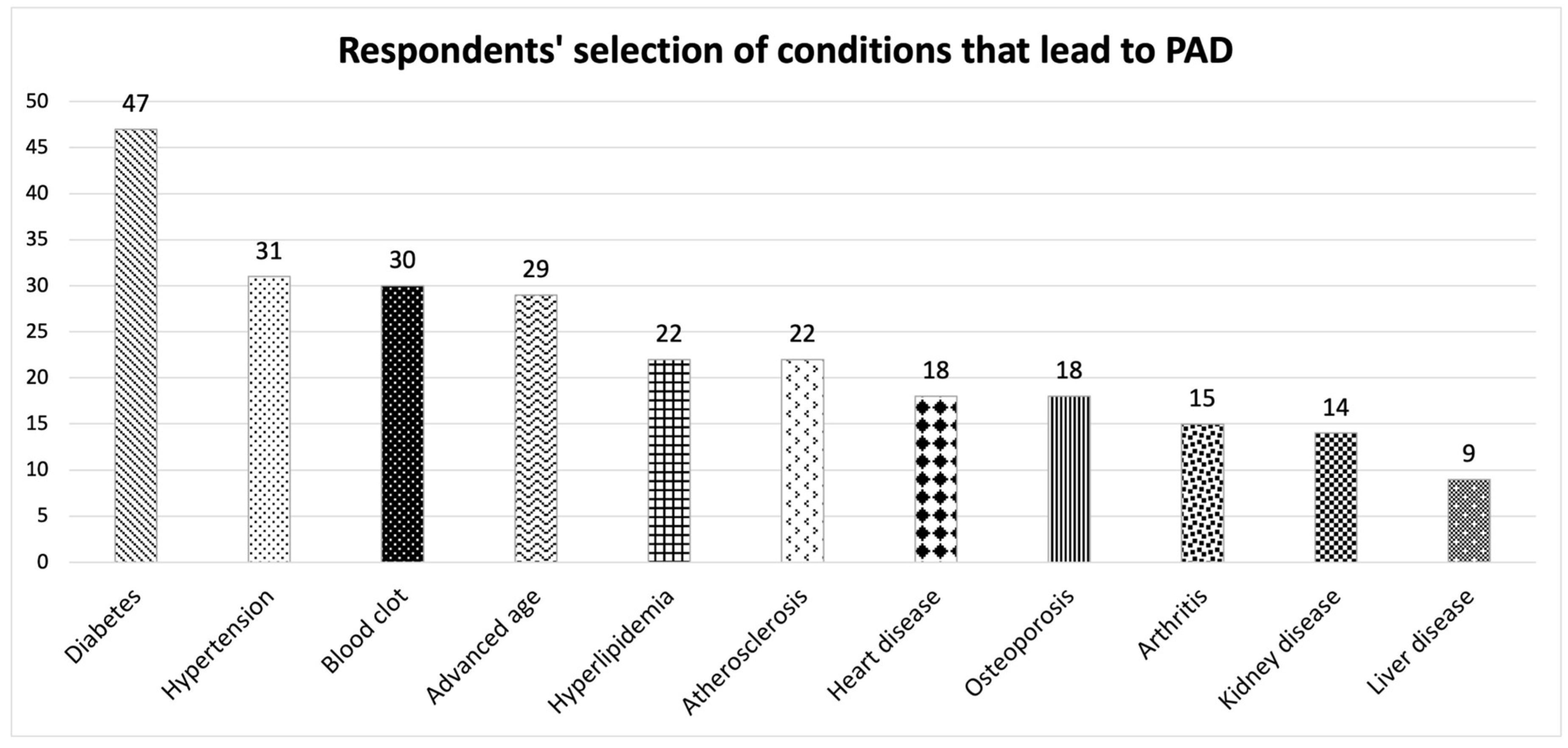
Figure 2.
The selected option highlighted the lack of understanding between wound healing and circulation, a key component for wound healing.
Figure 2.
The selected option highlighted the lack of understanding between wound healing and circulation, a key component for wound healing.
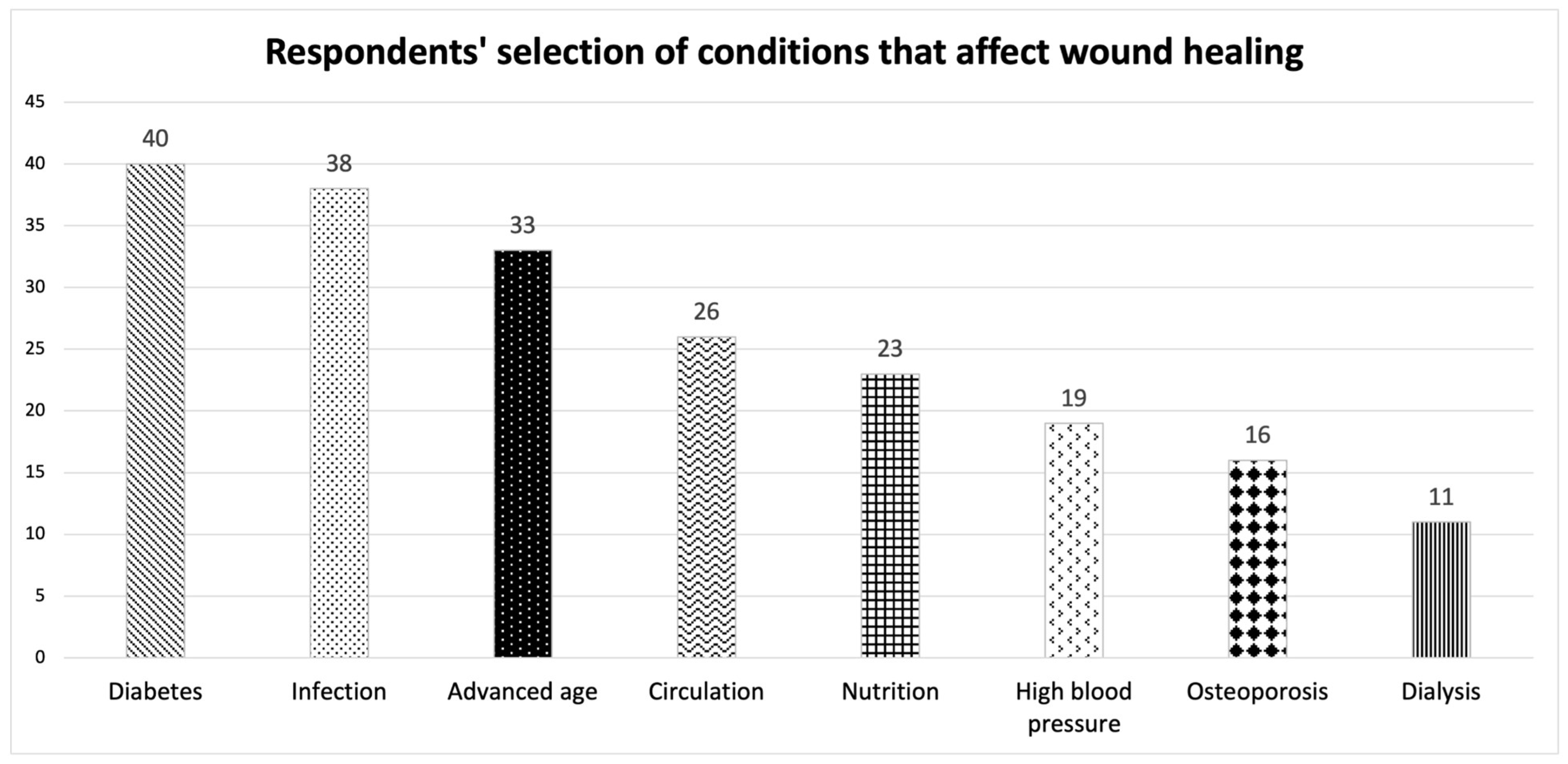
Figure 3.
The distribution of the selected conditions illustrated the lack of understanding of the signs and symptoms of PAD.
Figure 3.
The distribution of the selected conditions illustrated the lack of understanding of the signs and symptoms of PAD.
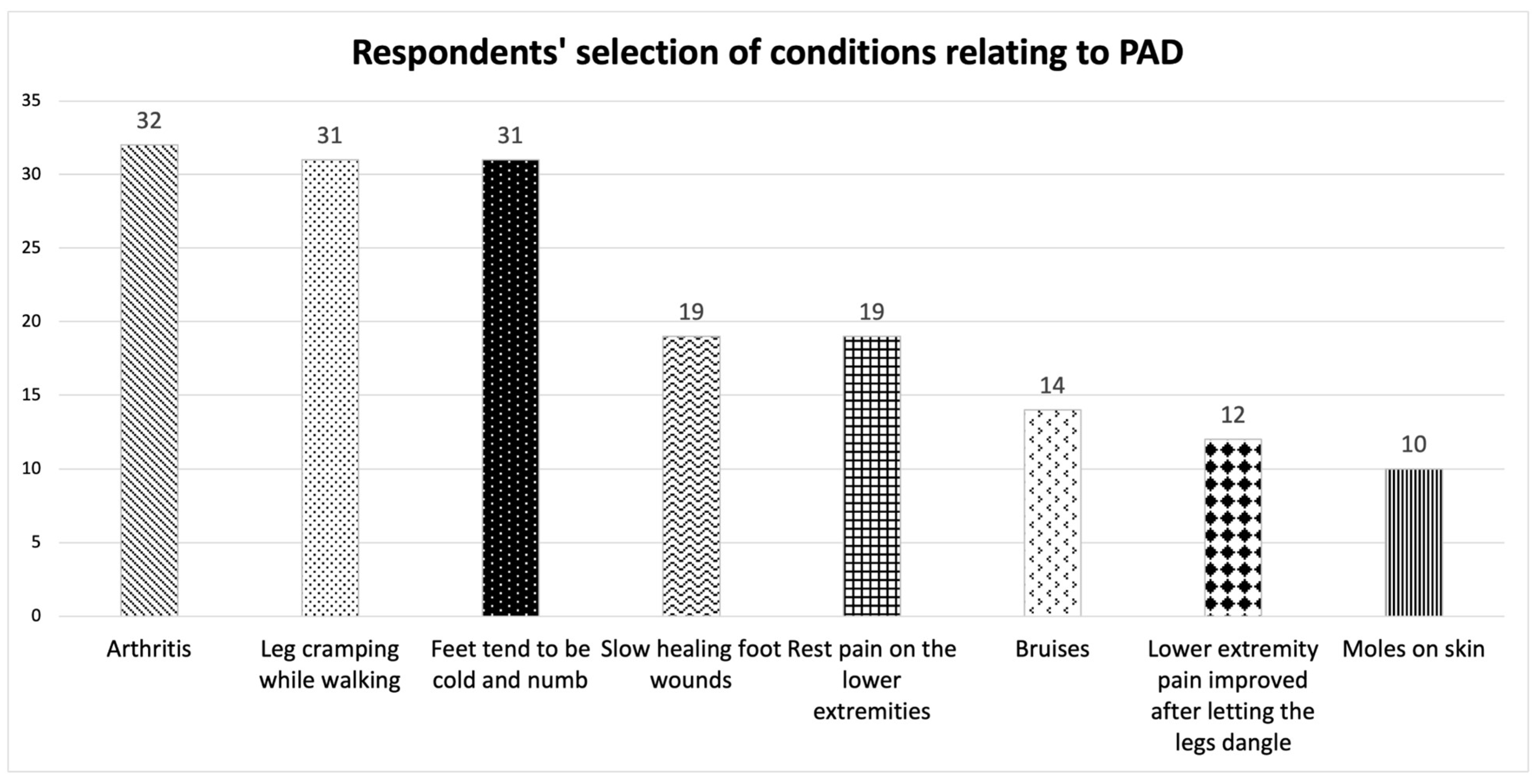
Figure 4.
Respondents’ preferred to see a family doctor (n=44) to treat foot wounds. The response may be driven by the type of insurance (i.e., Health Maintenance Organization aka HMO) in the local community.
Figure 4.
Respondents’ preferred to see a family doctor (n=44) to treat foot wounds. The response may be driven by the type of insurance (i.e., Health Maintenance Organization aka HMO) in the local community.
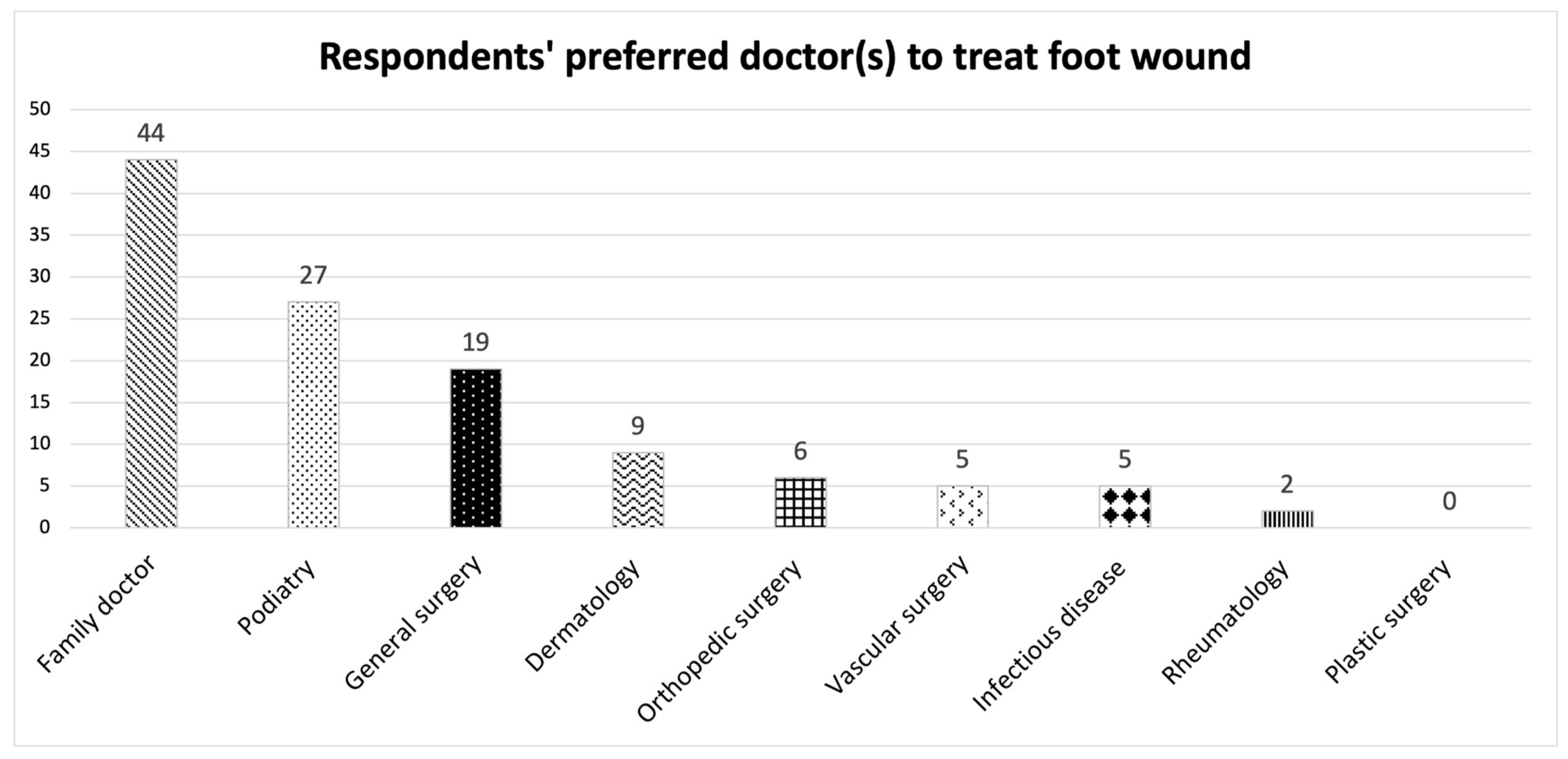
Figure 5.
Majority of the respondents preferred more traditional media, radio (n=49), newspaper (n=35), and television (n=32) to learn healthcare information. However, Internet-based media immediately followed the top three options.
Figure 5.
Majority of the respondents preferred more traditional media, radio (n=49), newspaper (n=35), and television (n=32) to learn healthcare information. However, Internet-based media immediately followed the top three options.

Inferential Analysis on Age, Gender and Educational Level v. Preferred Learning Methods
Among all demographic categories, age, gender and educational level demonstrated statistical significant association with preferred learning methods. The top three preferred methods to receive health information were radio (n=49), newspaper (n= 35), and television (n=32) [Figure 5]. We found a statistically significant association between participants’ educational level and whether the following methods were considered part of their top three learning styles: internet search (p < 0.001), TV (p = 0.008), radio (p = 0.043), and talking to clinical providers (p = 0.048)[Figure 7]. In logistic regression, Age (p=0.021) and English proficiency (p=0.008) were statistically significant for using radio to receive health information while 65 years old and above (OR 0.124, 95% CI [0.021- 0.0728]) as well as participants who were proficient in English (OR 0.078; 95% CI [0.012-0.52]) were less preferred using radio to receive health information. Male gender was statistically significant to use newspapers to receive health information as opposed to female (p=0.003, OR 5.26; 95% CI [1.76-15.69]).
When analyzing the relationship between the top 3 preferred learning methods and gender, 14/62 females preferred Video/Media, compared to just 1/27 males (p = 0.033). Additionally, 11/62 females preferred Talking to Providers while only 1/27 males chose this method (p = 0.084). Conversely, 16/27 males preferred Newspaper while 19/62 females selected Newspaper as their top 3 preferred learning methods (p = 0.008).
Figure 6.
The figure depicted the distribution of the study cohort and the awareness of PAD risk factors. The chi-square test for independence showed a statistically significant difference in PAD awareness among the age groups (p = 0.044). The highest proportion of ‘Yes’ responses was observed in the 75 to 85 age group while the majority of the survey respondents reported being unaware of the risk factors related to PAD.
Figure 6.
The figure depicted the distribution of the study cohort and the awareness of PAD risk factors. The chi-square test for independence showed a statistically significant difference in PAD awareness among the age groups (p = 0.044). The highest proportion of ‘Yes’ responses was observed in the 75 to 85 age group while the majority of the survey respondents reported being unaware of the risk factors related to PAD.
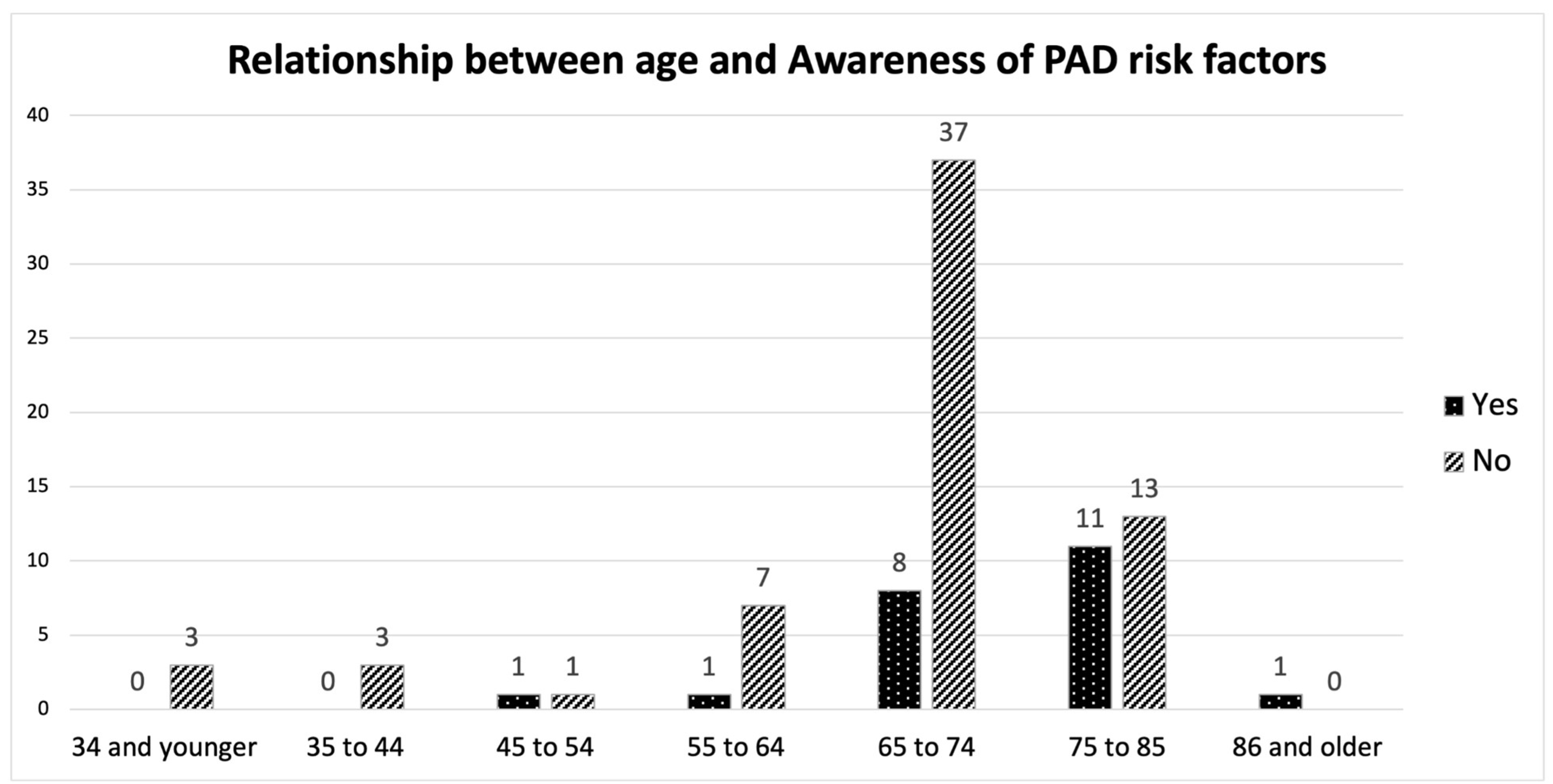
Figure 7.
The figure shows the distribution of respondents’ educational levels (high school or below vs. above high school) across preferred learning methods with statistically significant differences.internet search (p<0.001), television (p=0.008), radio (0.043), and talking to clinical providers (p=0.048).
Figure 7.
The figure shows the distribution of respondents’ educational levels (high school or below vs. above high school) across preferred learning methods with statistically significant differences.internet search (p<0.001), television (p=0.008), radio (0.043), and talking to clinical providers (p=0.048).
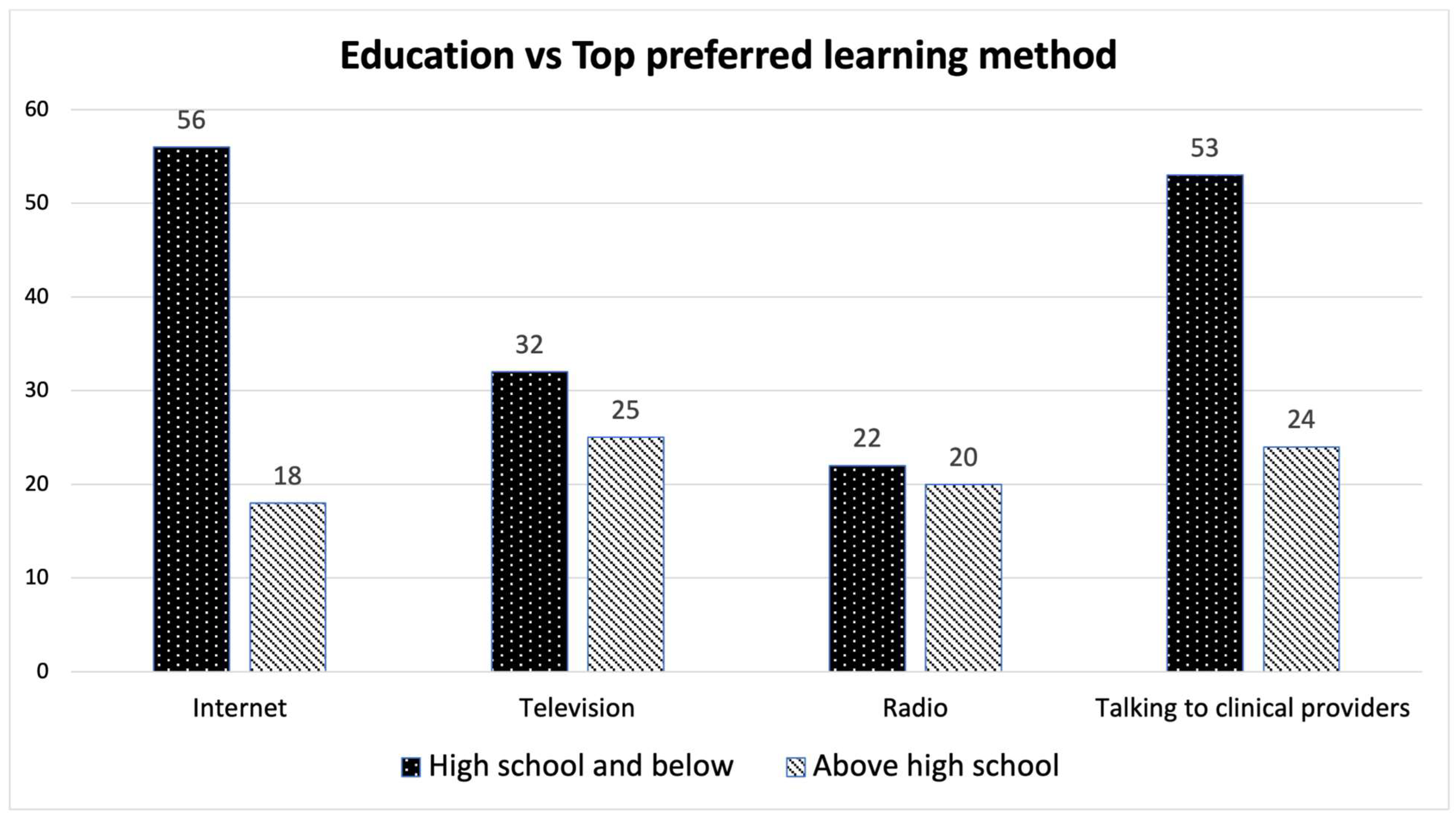
Figure 8.
The figure depicted the differences between the top three preferred learning methods and genders.
Figure 8.
The figure depicted the differences between the top three preferred learning methods and genders.
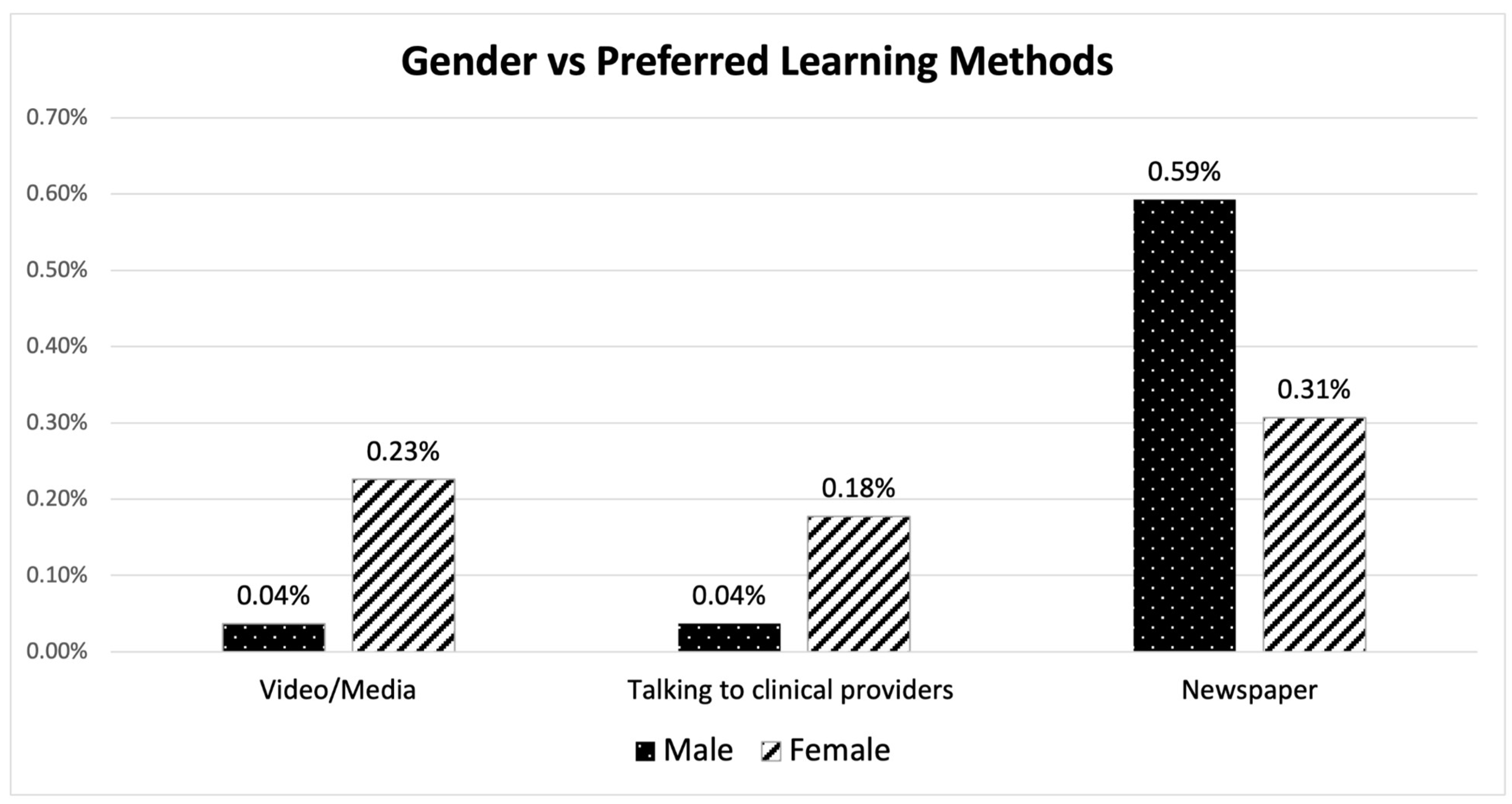
Discussion
To our knowledge, this is the first attempt to understand the current baseline knowledge of PAD in the Chinese-speaking population in the United States. Overall, only 32% of the survey population (29/91) reported prior knowledge about PAD. While many survey respondents thought that diabetes was a leading cause for PAD (47/76) and arthritis was thought to be the leading symptom related to PAD (32/65). This contradicting findings may further implicate the lack of knowledge in PAD in the survey population. The two cohorts that were surveyed had similar and suboptimal understanding of PAD and its complications which confirmed a health literacy gap among the Chinese-speaking population, particularly in San Francisco Chinatown. The top three methods to receive health information were radio, television and newspaper. Interestingly, 65 years old and above (OR 0.124, 95% CI [0.021- 0.0728]) as well as participants who were proficient in English (OR 0.078; 95% CI [0.012-0.52]) were less preferred using radio to receive health information. Male gender was statistically significant to use newspapers to receive health information as opposed to female (p=0.003, OR 5.26; 95% CI [1.76-15.69]). Our findings may suggest a community specific campaign to increase the awareness of PAD given that age, education level, gender and English proficiency may influence the media of choice to receive health information.
Age v. Preferred Learning Methods
Learning theory, specifically the Social Cognitive Theory of Learning, suggests that learning is influenced by peers. The theory may partially explain that adult learning is different from children. For instance, life experiences and generational background may influence adult learners’ learning. [14] As a result, the subject of adult learning is a very complex topic with significantly wide variations. For example, in our cohort, 65 years old and above were less preferred radio, a more traditional media, as a learning method for health information but radio was selected to be the number 1 learning method by the entire cohort. However, the younger generation (age 35 or younger) preferred email as opposed to the older generations in our surveyed cohort. Our findings indicate the choice of media to inquire health information is likely not effective with a single method. Consequently, based on the Social Cognitive Theory of Learning, specific campaigns and social media of choice will be designed and tailored to different age groups in the Chinese-speaking communities in San Francisco Chinatown in order to increase the awareness of PAD and its complications.
Education Level v. Preferred Learning Methods
Another factor that appeared to impact the preferred method of receiving health information is the level of education. Participants with higher education levels, such as some college or university graduates, preferred internet searches and video/media formats for obtaining health information. This is likely due to greater exposure to multimedia resources and as a result more familiarity and preference for these formats. In contrast, those with middle school education or below were more inclined to choose traditional media such as television, reflecting a digital divide linked to level of education. Literature supports this observation, indicating that higher educational attainment is positively associated with e-health literacy among older adults, enabling them to seek and utilize newer multimedia formats.[15] These results suggest that health literacy interventions should consider the educational background of the population. Tailored programs that utilize multimedia resources may be more effective for those with higher levels of education, however a more traditional approach may be necessary for those with lower educational levels. Tailoring educational methods this way may help bridge the digital divide and improve health literacy among elderly individuals.
Another interesting finding that may be related to the education level is the negative association between English proficiency and using radio as a preferred method to receive health information. Presumably Chinese-speaking immigrants who are proficient in English are likely to have higher education degrees. Although Chinese language may be their first language, they may feel more comfortable using methods which are English language based. While the above finding is interesting, it is not surprising. The top three selected preferred methods, radio, newspaper and television are readily available in Chinese-language in San Francisco Chinatown. Therefore, age and education level of the surveyed community in San Francisco Chinatown along with the English proficiency are likely associated with media that contains Chinese language.
Gender v Preferred Learning Methods
Methods to receive health information appeared to be different between reported genders. We found that female respondents demonstrated a statistically significant preference for Video/Media (p = 0.033) and Talking to Clinical Providers (p = 0.084) compared to their male counterparts in our population. This inclination towards multimedia formats aligns with broader societal trends, where women are more attracted towards visual and interactive modes of communication. Conversely, males exhibited a preference for traditional learning methods, as evidenced by the results showing newspapers as one of their top three choices (p = 0.008) compared to females. Research in educational psychology suggests that females tend to engage more deeply with content presented through dynamic visual stimuli, finding it conducive to their learning styles. [16]
Albert Bandura’s Social Cognitive Theory emphasizes that individuals learn by observing and emulating role models, especially those they admire or perceive as successful.[18] This theory can be linked to our findings on the lack of knowledge about PAD in the Chinese-speaking population in San Francisco. The gaps in health literacy highlighted in the study suggest that targeted health education strategies should consider the social and cultural dynamics of the population. For example, trusted figures in the community, such as healthcare professionals or media personalities in Chinese-speaking media channels (radio, television, and newspapers), could serve as influential role models to spread accurate information about PAD. By using respected figures, a culturally tailored campaign could bridge the health literacy gap, encouraging individuals to emulate the health-seeking behaviors of these role models, such as seeking early diagnosis and treatment of PAD. This approach, in line with Bandura’s theory, would not only promote awareness but also foster behavioral change through social learning, thereby improving health outcomes within this community.
Conclusion
These findings highlighted the complexity of an individual population. In the study cohort, although they shared very similar ethnic and cultural backgrounds, the methods to inquire health knowledge were influenced by gender, age and level of education. .As a result, a more comprehensive approach using multiple social media channels may be necessary to increase the awareness and understanding of a disease, such as PAD. . Future research may further investigate the effectiveness of these tailored health education strategies in increasing awareness and health outcomes. Finally, employing a strategy based on the Social Cognitive Learning Theory, which has been proven effective in adult learning, may solidify knowledge about PAD among individual populations.
Funding
The presented project was funded by an internal grant, Scott Beamer Award from Samuel Merritt University.
Acknowledgement
This article is a revised and expanded version of a poster abstract, Peripheral Arterial Disease Health Literacy and Learning Preferences in a Chinese-Speaking Population, [19] which was presented at DFcon 2023 - Diabetic Foot Conference, Anaheim, CA, USA, September 28, 2023 - September 30, 2023.
References
- Aday, A.W.; Matsushita, K. Epidemiology of Peripheral Artery Disease and Polyvascular Disease. Circ. Res. 2021, 128, 1818–1832. [Google Scholar] [CrossRef] [PubMed]
- Creager, M.A.; Matsushita, K.; Arya, S.; Beckman, J.A.; Duval, S.; Goodney, P.P.; Gutierrez, J.A.T.; Kaufman, J.A.; Joynt Maddox, K.E.; Pollak, A.W.; et al. Reducing Nontraumatic Lower-Extremity Amputations by 20% by 2030: Time to Get to Our Feet: A Policy Statement From the American Heart Association. Circulation 2021, 143, e875–e891. [Google Scholar] [CrossRef] [PubMed]
- Gornik, H.L.; Aronow, H.D.; Goodney, P.P.; Arya, S.; Brewster, L.P.; Byrd, L.; Chandra, V.; Drachman, D.E.; Eaves, J.M.; Ehrman, J.K.; et al. 2024 ACC/AHA/AACVPR/APMA/ABC/SCAI/SVM/SVN/SVS/SIR/VESS Guideline for the Management of Lower Extremity Peripheral Artery Disease: A Report of the American College of cardiology/American Heart Association Joint Committee on Clinical Practice Guidelines. Circulation 2024, 149, e1313–e1410. [Google Scholar] [CrossRef] [PubMed]
- Tan, T.-W.; Shih, C.-D.; Concha-Moore, K.C.; Diri, M.M.; Hu, B.; Marrero, D.; Zhou, W.; Armstrong, D.G. Disparities in Outcomes of Patients Admitted with Diabetic Foot Infections. PLoS One 2019, 14, e0211481. [Google Scholar] [CrossRef] [PubMed]
- Armstrong, D.G.; Tan, T.-W.; Boulton, A.J.M.; Bus, S.A. Diabetic Foot Ulcers: A Review. JAMA 2023, 330, 62–75. [Google Scholar] [CrossRef] [PubMed]
- Coughlin, S.S.; Vernon, M.; Hatzigeorgiou, C.; George, V. Health Literacy, Social Determinants of Health, and Disease Prevention and Control. J. Environ. Health Sci. 2020, 6. [Google Scholar]
- Walters, R.; Leslie, S.J.; Polson, R.; Cusack, T.; Gorely, T. Establishing the Efficacy of Interventions to Improve Health Literacy and Health Behaviours: A Systematic Review. BMC Public Health 2020, 20, 1040. [Google Scholar] [CrossRef] [PubMed]
- Criqui, M.H.; Matsushita, K.; Aboyans, V.; Hess, C.N.; Hicks, C.W.; Kwan, T.W.; McDermott, M.M.; Misra, S.; Ujueta, F. ; American Heart Association Council on Epidemiology and Prevention; Council on Arteriosclerosis, Thrombosis and Vascular Biology; Council on Cardiovascular Radiology and Intervention; Council on Lifestyle and Cardiometabolic Health; Council on Peripheral Vascular Disease; and Stroke Council Lower Extremity Peripheral Artery Disease: Contemporary Epidemiology, Management Gaps, and Future Directions: A Scientific Statement From the American Heart Association. Circulation 2021, 144, e171–e191. [Google Scholar] [PubMed]
- Berkman, N.D.; Sheridan, S.L.; Donahue, K.E.; Halpern, D.J.; Crotty, K. Low Health Literacy and Health Outcomes: An Updated Systematic Review. Ann. Intern. Med. 2011, 155, 97–107. [Google Scholar] [CrossRef]
- Aljassim, N.; Ostini, R. Health Literacy in Rural and Urban Populations: A Systematic Review. Patient Educ. Couns. 2020, 103, 2142–2154. [Google Scholar] [CrossRef]
- Chew, S.; Heckman, J. Education and Preferences: Experimental Evidences from Chinese Adult Twins. 2010.
- Snibbe, A.C.; Markus, H.R. You Can’t Always Get What You Want: Educational Attainment, Agency, and Choice. J. Pers. Soc. Psychol. 2005, 88, 703–720. [Google Scholar] [CrossRef] [PubMed]
- Janssen, E.M.; Longo, D.R.; Bardsley, J.K.; Bridges, J.F. Education and Patient Preferences for Treating Type 2 Diabetes: A Stratified Discrete-Choice Experiment. Patient Prefer. Adherence 2017, 11, 1729–1736. [Google Scholar] [CrossRef]
- Fenwick, T.; Tennant, M. Understanding Adult Learners. Dimensions of Adult Learning 2020. [Google Scholar] [CrossRef]
- Shi, H.; Gazal, S.; Kanai, M.; Koch, E.M.; Schoech, A.P.; Siewert, K.M.; Kim, S.S.; Luo, Y.; Amariuta, T.; Huang, H.; et al. Population-Specific Causal Disease Effect Sizes in Functionally Important Regions Impacted by Selection. Nat. Commun. 2021, 12, 1098. [Google Scholar] [CrossRef] [PubMed]
- Marantika, J.E.R. Metacognitive Ability and Autonomous Learning Strategy in Improving Learning Outcomes. J. Educ. Learn. (EduLearn) 2021, 15, 88–96. [Google Scholar] [CrossRef]
- Halpern, D.F.; Benbow, C.P.; Geary, D.C.; Gur, R.C.; Hyde, J.S.; Gernsbacher, M.A. The Science of Sex Differences in Science and Mathematics. Psychol. Sci. Public Interest 2007, 8, 1–51. [Google Scholar] [CrossRef] [PubMed]
- Bandura, A. Health Promotion from the Perspective of Social Cognitive Theory. Psychol. Health 1998, 13, 623–649. [Google Scholar] [CrossRef]
- Lee, T.; Hassan, S.; Chau, H.; Shih, C.D. Peripheral Arterial Disease Health Literacy and Learning Preferences in a Chinese-Speaking Population, DFcon 2023 - Diabetic Foot Conference, Anaheim, CA, USA, September 28, 2023 - September 30, 2023.
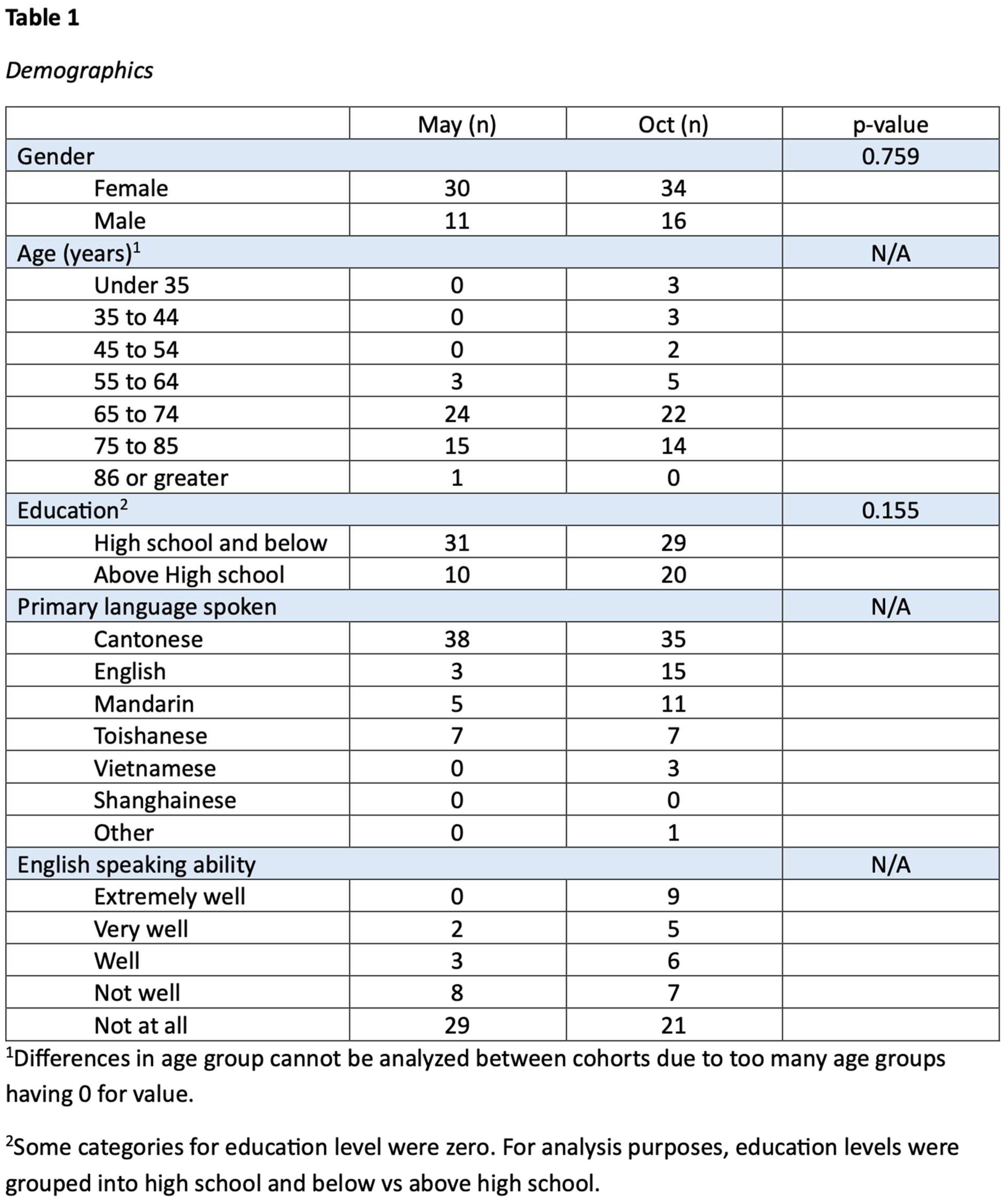
Disclaimer/Publisher’s Note: The statements, opinions and data contained in all publications are solely those of the individual author(s) and contributor(s) and not of MDPI and/or the editor(s). MDPI and/or the editor(s) disclaim responsibility for any injury to people or property resulting from any ideas, methods, instructions or products referred to in the content. |
© 2024 by the authors. Licensee MDPI, Basel, Switzerland. This article is an open access article distributed under the terms and conditions of the Creative Commons Attribution (CC BY) license (http://creativecommons.org/licenses/by/4.0/).
Copyright: This open access article is published under a Creative Commons CC BY 4.0 license, which permit the free download, distribution, and reuse, provided that the author and preprint are cited in any reuse.
Downloads
61
Views
71
Comments
0
Subscription
Notify me about updates to this article or when a peer-reviewed version is published.
MDPI Initiatives
Important Links
© 2025 MDPI (Basel, Switzerland) unless otherwise stated







